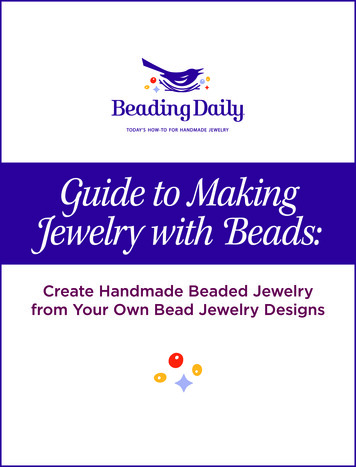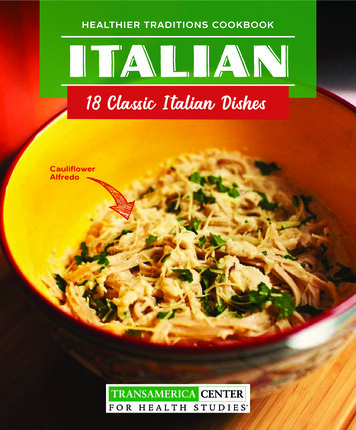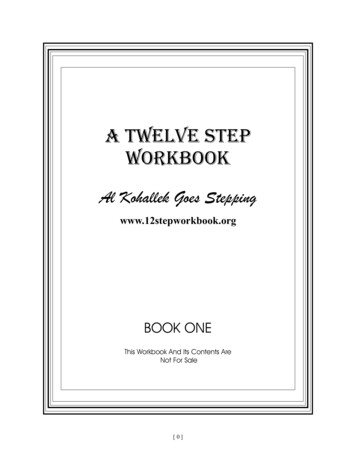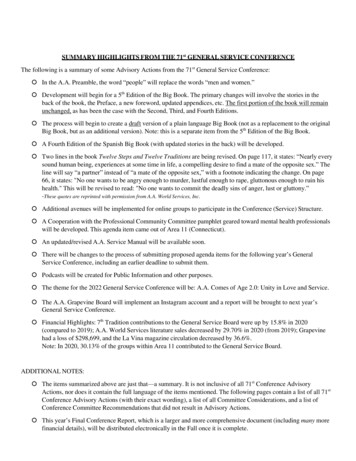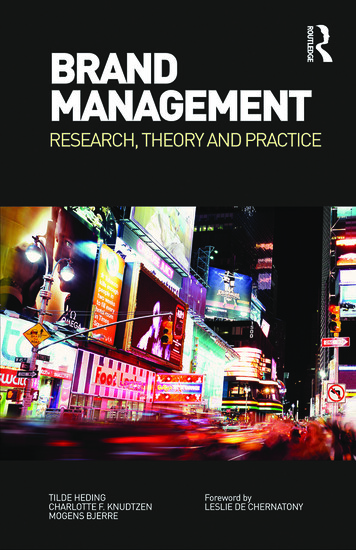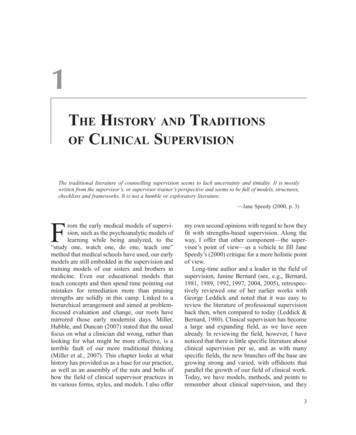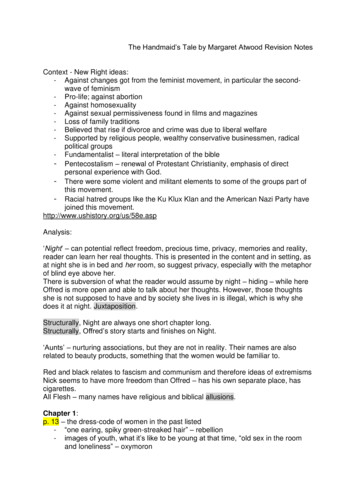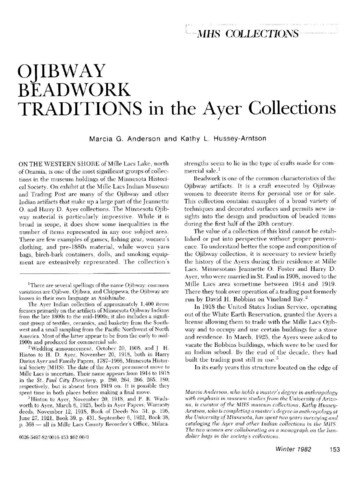
Transcription
MHS a)LLECTKJNSOJIBWAYBEADWORKTRADITIONS in the Ayer CollectionsMarcia G. Anderson and Kathy L. Hussey-ArntsonO N T H E W E S T E R N S H O R E of Mille Lacs L a k e , n o r t hof O n a m i a , is o n e of t h e m o s t significant g r o u p s of collections in t h e m u s e u m h o l d i n g s of t h e M i n n e s o t a H i s t o r i cal Society. O n e x h i b i t at t h e Mille Lacs I n d i a n M u s e u mand T r a d i n g P o s t a r e m a n y of t h e O j i b w a y a n d o t h e rIndian artifacts t h a t m a k e u p a l a r g e p a r t of t h e J e a n n e t t eO. a n d H a r r y D . A y e r collections. T h e M i n n e s o t a O j i b way m a t e r i a l is p a r t i c u l a r l y i m p r e s s i v e . W h i l e it isb r o a d in s c o p e , it d o e s s h o w s o m e i n e q u a l i t i e s in t h en u m b e r of i t e m s r e p r e s e n t e d in any o n e s u b j e c t area.T h e r e a r e few e x a m p l e s of g a m e s , fishing gear, w o m e n ' sclothing, and pre-1880s material, while woven yarnbags, b i r c h - b a r k c o n t a i n e r s , dolls, a n d s m o k i n g e q u i p m e n t are extensively r e p r e s e n t e d . T h e collection's' T h e r e are several spellings of the name Ojibway: commonvariations are Ojibwe, Ojibwa, and Chippewa; the Ojibway areknown in their own language as Anishinabe.The Ayer Indian collection of approximately 1,400 itemsfocuses primarily on the artifacts of Minnesota Ojibway Indiansfrom the late 1800s to the mid-1900s; it also includes a significant group of textiles, ceramics, and basketry from the Southwest and a small sampling from the Pacific Northwest of NorthAmerica. Most of the latter appear to be from the early to mid1900s and produced for commercial sale. Wedding announcement, October 20, 1908, and J H.Hinton to H. D. Ayer, November 20, 1918, both in HarryDarius Ayer and Family Papers, 1787-1966, Minnesota Historical Society (MHS). The date of the Ayers' permanent move toMille Lacs is uncertain. Their name appears from 1914 to 1918in the St. Paul City Directory, p. 280, 264, 266, 265, 180,respectively, but is absent from 1919 on. It is possible theyspent time in both places before making a final move. Hinton to Ayer, November 20, 1918, and P. R. Wadsworth to Ayer, March 6, 1925, both in Ayer Papers; Warrantydeeds, November 12, 1918, Book of Deeds No. 31, p. 196,June 27, 1921, Book 39, p. 431, September 6, 1922, Book 38,p. 368 — all in Mille Lacs County Recorder's Office, Milaca.0026-5497-82/0016-153 02.00/0s t r e n g t h s s e e m to lie in t h e t y p e of crafts m a d e for c o m m e r c i a l sale. R e a d w o r k is o n e of t h e c o m m o n c h a r a c t e r i s t i c s of t h eO j i b w a y a r t i f a c t s . It is a craft e x e c u t e d b y O j i b w a yw o m e n to d e c o r a t e i t e m s for p e r s o n a l u s e or for sale.T h i s collection c o n t a i n s e x a m p l e s of a b r o a d v a r i e t y oft e c h n i q u e s a n d d e c o r a t e d surfaces a n d p e r m i t s n e w insights into t h e d e s i g n a n d p r o d u c t i o n of b e a d e d i t e m sd u r i n g t h e first half of t h e 2 0 t h c e n t u r y .T h e v a l u e of a c o l l e c t i o n of this k i n d c a n n o t b e e s t a b l i s h e d or p u t i n t o p e r s p e c t i v e w i t h o u t p r o p e r p r o v e n i e n c e . T o u n d e r s t a n d b e t t e r t h e s c o p e a n d c o m p o s i t i o n oft h e O j i b w a y c o l l e c t i o n , it is n e c e s s a r y to r e v i e w brieflyt h e h i s t o r y of t h e A y e r s d u r i n g t h e i r r e s i d e n c e at M i l l eLacs. M i n n e s o t a n s J e a n n e t t e O . F o s t e r a n d H a r r y D .Ayer, w h o w e r e m a r r i e d in St. P a u l in 1908, m o v e d to t h eMille Lacs a r e a s o m e t i m e b e t w e e n 1914 a n d 1919.T h e r e t h e y took o v e r o p e r a t i o n of a t r a d i n g p o s t f o r m e r l yrun by David H . Robbins on Vineland Ray."I n 1918 t h e U n i t e d S t a t e s I n d i a n S e r v i c e , o p e r a t i n go u t of t h e W h i t e E a r t h R e s e r v a t i o n , g r a n t e d t h e A y e r s alicense a l l o w i n g t h e m to t r a d e w i t h t h e M i l l e Lacs O j i b way a n d to o c c u p y a n d u s e c e r t a i n b u i l d i n g s for a s t o r ea n d r e s i d e n c e . In M a r c h , 1925, t h e A y e r s w e r e a s k e d t ov a c a t e t h e R o b b i n s b u i l d i n g s , w h i c h w e r e to b e u s e d foran I n d i a n school. By t h e e n d of t h e d e c a d e , t h e y b a db u i l t t h e t r a d i n g p o s t still in u s e . I n its e a r l y y e a r s this s t r u c t u r e l o c a t e d o n t h e e d g e ofMarcia Anderson, who liolds a master's degree in anthropologywith emphasis in museum studies from the University of Arizona, is curator of the MHS museum collections. Kathy HusseyArntson, who is completing a master's degree in anthropology atthe University of Minnesota, has spent two years surveying andcataloging the Ayer and other Indian collections in the MHS.The two women are collaborating on a monograph on the bandolier bags in the society'scollections.Winter 1982153
HARRY AYER, hiswife Jeannette, andtheir friend0-gee-tup,about1920the Ojibway community, near what was to becomeMille Lacs Reservation, served as a general store for thelocal residents, primarily Vlille Lacs Ojibway. In theyears that followed, the Ayers added a number of otherbusinesses, including rental cottages, the construction,sale, and repair of boats, a maple syrup and sugar business, and fisherman guide services. The Ayers interest inthe local community led to personal collecting of Ojibway artifacts, as well as purchasing local craftwork forsale at the post. They also bought Indian goods to sell atthe post from numerous North American firms in Arizona, New VIexico, Te.xas, Alaska, and elsewhere. The Ayers were neighbors, friends, employers ofand vendors for the Ojibway at Mille Lacs. Because thevarious Indian agents employed by the United StatesBureau of Indian Affairs for the Mille Lacs band werenearly 170 miles away at the White Earth Reservation,Harry Ayer assumed the role of mediator, executor, oradministrator of Ojibway estates and acted occasionallyas their spokesman to the White Earth agents. Over the years souvenirs became the mainstay ofthe Ayers' business, and the trading post became less ofa general store. In 1959 VIr. and Mrs. Ayer, seven yearsbefore their deaths, donated their entire estate to theVIHS. The gift included 104 acres of land, the post, anew building for exhibiting their collections, and a trustfund to support and expand the museum. The tradingpost is now the bookstore and gift shop for the Mille LacsIndian Museum.SINCE the Ayers and the early 20th-century Ojibwayartists and craftsmen are no longer living, photographs inthe society's audio-visual library and documentary evi154Minnesota Historydence such as business records in the division of archivesand manuscripts help to piece together the story behindthe collections. While much information can be gainedfrom this material, the data are spotty and incomplete.As a result of some recent efforts to supplement the Ayerrecords, copies of Southwest trader Lorenzo Hubbell'sletters to the Minnesotans are now in the couple'spapers. The development of a commercial relationship between the Ayers and the Mille Lacs band is particularlyapparent in the trading post account ledgers. The Ayersordered merchandise from bead supply companies thatimported their beads from European manufacturers, andthe Mille Lacs Ojibway purchased beads, velvet, thread,needles, braid, cloth, and ribbon at the post. Entriesrelating to the production of beaded items, recordedunder the name of the purchaser, appear frequently inthe ledgers. In the late 1920s and early 1930s the tradingpost accounts of Dick Skinaway, Mrs. John Dorr, Sr.,John Vlink, Taylor and Jim Hanks, Vlaggie Skinaway,Frank Nickaboine, Jess Wadena, Dick Garbow, Jim andVIrs. Sam Keg, Equay, Mrs. Joe Shakopee, and SamMitchell indicate that someone in each family was doingbeadwork. One Ojibway customer, Jim Hanks, boughtsupplies over a six-month p e r i o d in 1929 that included beads at 1.50, thread at .21, and needles at .05. Some of these family names can be tied directly tobeaded items in the collection today.'The ledger records do not describe how the materials The Ayers formed the Vlille Lacs Products Co. with JohnMartin and T. H. Croswell to manufacture and sell maplesyrup and sugar, sorghum, boats, and toys; Certificate of Incorporation, June, 1930, in Ayer Papers. See also Ayer to LorenzoHubbell Co. and to Zuni (New Mexico) Trading Post, bothMay 31, 1945; R. Ortega and Go. (El Paso) to Ayer, June 7,1945; Don G. Foster of Juneau, Alaska, to Ayer, May 14, 1946;receipt for shipment from Southwest Arts and Crafts (Santa Fe)March 2, 1945; Henry S. Beach to Ayer, June 2, 1945 — all inAver Papers. 'Here and below, see Russell W. Fridley, May 11, 1959,and Leonard Lampert, Jr., July 28, 1959, both to Mr. and Mrs.Ayer, Ayer Papers. The Ayer Papers are replete with evidenceof their relationship with the Indians; see, for example, G. V.Peel to Ayer, November 7, 1919, P. R. Wadsworth to Ayer,July 21, 1921, and Ayer to Blanche La Du, February 10, 1933.'"Ayer to Lorenzo Hubbell, Vlay 19, 1943, Ayer Papers;Hubbell Estate to Vlille Lacs Indian Trading Post, June 7,1943, University Library Special Collections, University ofArizona, Tucson, copy in Ayer Papers. 'Accession no. 10,000.815-836; Walco Bead Go. to MilleLacs Indian Trading Post, February 28, 1930, January 12,1932, and to H. D. Ayer, September 1, 1936, in accession files,MHS museum collections department; Trading Post AccountLedger, vol. 76, p. 12, 26, 32, 58, 64, 70, 74, 87, 117, 119, 120,125, 133, 140, [1929], Ayer Papers. These names, shown asthey appear in the ledger, have various spellings; many womenbore only Ojibway names and the Ayers listed them undertheir married English names.
YOUNG FrankieHanks posed forthe Ayers at MilleLacs in 19.37.HIS BREECHCLOTHis made of blanket wooland decorated withfloral spot-stitch embroidery. Accession no.10,000.145.purchased at the post were used, but this informationcan be obtained by examining the items themselves. TheOjibway beadwork in the Ayer collection exemplifiesmost of the design and style characteristics seen in thiscraft during the 19th and 20th centuries. It decoratesobjects made from velvet, trade wool, leather, andbirch bark, as well as items composed entirely of beads.One distinctive feature of this beadwork is the use ofcolor. The Ojibway do not express color preferences somuch as they reveal a desire to use a wide variety ofcolors. One exception to this might be the color chosenfor the background: dark backgrounds are often made ofcloth (black, dark blue, or red); light backgrounds generally are created by filling in the area with beads (white,gray, or transparent). Before the use of dark cloth,tanned animal skins were dyed black as a background forthe porcupine quillwork that was common until decoration with beadwork began. Untd the late 1800s, colorswere few, and all-white designs were more prevalent. The Ojibway use a number of different designs andtechniques in their beadwork. The two major designs arefloral-curvdinearand geometric, and these are often*Garrie A. Lyford, The Crafts of the Ojibwa, 151 (Education Division, Office of Indian Affairs, Indian HandcraftSeries, vol. 5 — Washington, D.C., 1942); Frances Densmore,Chippewa Customs, 191 (Reprint ed., St. Paul, 1979).BANDOLIERorshoulder bag,probably made inthe 20th centuryfor Ed Skinaway,a Mille LacsOjibway; it isdecorated with spot-.stitch, floral bead embroideryand non-Indian motifs. Accession no. 10,000.615.Color photography here and on the followingpages is by EricMortenson.found in combination. Less cominon designs includezoomorphic, anthropomorphic, dream, and clan symbols. From non-Indian cultures the Ojibway frequentlyincorporate motifs like flags, cornucopias, pineapples,and script or printing. Border motifs are most commonlycomposed of a variety of geometric patterns such as zigzag lines, strings of diamonds, and a traditional Ojibwaymotif called otter tail.Of the many different designs to be seen in the Ayercollection, the floral-curvilinear is the most frequent. Itis found alone and in combination with most of the otherdesigns. Common floral motifs include oak leaves, wildroses, grapevines, lilies, pine cones, and a pomegranateshape that might also be a stylized acorn.Geometric designs are well represented but are lesscommon in the Ayer collection. The technical sophistication of Ojibway geometric design is apparent in the combinations of a variety of motifs. Frequently, popularmotifs such as stylized flowers, diamonds, stars, Vshapes, crosses, and arrows were used in conjunctionwith each other.The beadwork on Ojibway bandolier bags often combines floral-curvilinear and geometric designs with othermotifs. Maple leaves, vines, and flowers combined withcornucopias, an American shield, and the name "EdSkinaway" applied in script decorate one such bag in theAyer collection. A n o t h e r one i n c o r p o r a t e s severalWinter 1982155
A FINGER-WOVENyarn sash with uhitepony bead decoration, probably early 19thcentury. Accession no10,000.173.A MULTICOLORED,braidedbead necklace with ribbon trim,originally in the collection of IndianService employee JohnHoward.Acces.sion no. 10,000.730.1THIS BANDOLIERbag, withgeometric,loom-wovenbeadwork on trade wool andcotton cloth and a ribbonborder, is characteristic ofearlier work done between 1860and 1880. Accession no.10,000.152.geometric motifs, a zigzag and diamond-banded border,and two representations of thunderbird spirits. BEADWORK techniques influence design motifs andaffect the choice of medium to which they are applied. Afloral vine theme, for example, cannot be replicated on abirch-bark container with the same effectiveness as ona velvet breechcloth. Most floral-curvilinear designsare produced by a technique referred to as spot-stitchembroidery, in which strands of beads are stitched to thesurface every two or three beads. When the Ojibwaybeadworker places the beads, she follows the motif'soutline working freehand from the outer edge to thecenter, rather than applying beads in straight lines, upand down, or left and right.In contrast, loom-woven beadwork lends itself almostexclusively to geometric designs. The beadworker employs linen or cotton thread to warp a rectangular frame.The warping can be single or double, and beads areworked in with a needle and the weft thread. One beadis placed between each warp or pair of warps, using aplain weave, under-and-over technique, resulting in adesign commonly referred to as square weave. The Ayer collection also contains several examples ofmore unusual technicjues. One necklace was produced156Minnesota Historyby b r a i d i n g t o g e t h e r c l u s t e r s of b e a d e d strands.Another, an early 19th-century example, is a fingerwoven sash of wool yarn. White pony beads decorate thesash in interwoven geometric designs that are insertedduring the weaving process. A thread prestrung withbeads crosses over and under the woolen warp and weftthreads. Additional techniques displayed in the collection are horizontal net weave, beaded edge finish, daisychain, and strung beads used in necklaces and fringe.These techniques require numerous supplies, includingneedles, thread, sinew (used in older examples), glass orfaceted metal beads (including seed, pony, necklace, andtubular size), sequins, and a surface onto which thebeads are applied (velvets, trade wools, tanned animalskins, birch bark, cottons, or ribbons). **Accession nos. 10,000.615 and 10,000.152, in MHSmuseum department. A bandolier bag is a decorated shoulderpouch usually worn by men on ceremonial occasions. Suchbags have been particularly popular with Woodlands Indianssince the 19th century.'"David A. Armour, '"Beads in the Upper Great Lakes: AStudy in Acculturation, " in Beads: Their Use by Upper GreatLakes Indians, 14-17 (Exhibit catalog. Public Museum Publication No. 3, Grand Rapids, Mich., 1977)."Accession nos. 10,000.730, 10,000.730.1, MHS museum.On the sash technique, see Armour, in Beads, 17.
M" " A BIRCH-BARK napkin ring,embellished with geometricloom-woven beadwork.Accession10,000.671.noSPOT-STITCH floral beadworkdecoratesthis small leather purse. The .strap is loomwoven beads that have stylizedflowermotifs. Accession no. 10,000.725.A MAUKAK, or birch-barkcontainer,evidently made to be sold at the tradingpost. Accession no. 10.000.25.Whether bead supplies decorated personal familyapparel or items to be sold at the trading post is unclear.The Ayer collection has several good examples of bothgroups. Many Ojibway beadworkers decorated leggings,breechcloths, wrist cuffs, armbands, moccasins, belts,sashes, dresses, bandolier bags, pipe bags, vests, shirtfront panels, drum bands, cradleboard bands, dolls,quivers, knife and awl cases, knee garters, and courtingflutes for themselves or family and community members. The Ayer collection contains examples of theseitems, with specific ones made by family members of EdSkinaway, Jim Hanks, Mary Hudson Barney (known as"Chi Bi Bi"), and Charlie Boyd. But crafts decorated for sale in the trading post wereusually of a different nature. Many objects such as napkin rings, pincushions, watch fobs, bracelets, purses.' Accession nos. 10,000.615, 10,000.145, 10,000.619, and10,000.620, in MHS museum department.' Indian Room Inventory, vol. 88, Fall, [1940]; SouvenirInventory, vol. 90, 1946; Souvenir Room Inventory, vol. 89,1947-50; "Summary of Goods Bought from Indians in 1927"— all in Ayer Papers."Telephone interview with Floyd Ballinger, site managerat the Mille Lacs Indian Museum and Trading Post, April 30,1982.MILLE LACS residentsGeorgeNickaboine, GeorgePendageyosh,and Jim Hanks, Jr. in 1930, wearing beaded outfits reserved for .special occasionsand bookmarks are forms from non-Ojibway cultures.More traditional decorated pieces are moccasins, beadedbags, neck chains, and birch-bark containers. In 1927 theAyers purchased beaded and other souvenir goods fromthe Ojibway totaling 2,209.25, and the society continues to purchase beadwork and other crafts for theMifle Lacs Indian Museum and Trading Post. '' Women are the traditional beadworkers among theOjibway. While they continue to use many of the earliertechniques and designs, they also create new motifs anddiscover new surfaces and objects to decorate. Sold atthe post today are belt buckles, earrings, key chains, andeyeglass cases as well as moccasins, bags, necklaces, andpendants. Young Ojibway women are doing beadwork,although they are also busy with full-time jobs and otheractivities. Some of the most active beadworkers in theMille Lacs band — Maude Kegg, Batiste Sam, LorenaCahbow, Margaret Hill, and Cecelia Dorr, for example— are descendants of those beadworkers who sold theirwork to Harry and Jeannette Ayer in the first half of thisc e n t u r y . " The whole story of the Ojibway beadworkersat Mifle Lacs remains to be told, but thanks to the scopeof the Ayer collections, the society is beginning to document the important and ongoing tradition of a nativecraft technique.Winter 1982157
Copyright of Minnesota History is the property of the MinnesotaHistorical Society and its content may not be copied or emailed tomultiple sites or posted to a listserv without the copyright holder’sexpress written permission. Users may print, download, or emailarticles, however, for individual use.To request permission for educational or commercial use, contact us.www.mnhs.org/mnhistory
Mitchell indicate that someone in each family was doing beadwork. One Ojibway customer, Jim Hanks, bought supplies over a six-month period in 1929 that in cluded beads at 1.50, thread at .21, and needles at .05. Some of these family names can b
